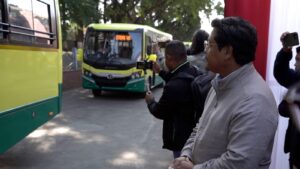
The state government’s efforts to reduce traffic congestion in Shillong have been applauded by the coram of the hearing comprised Hon’ble Mr. Justice Sanjib Banerjee, Chief Justice, and Hon’ble Mr. Justice W. Diengdoh, Judge of Hon’ble High Court of Meghalaya. The hon’ble high court said this while Philip Khrawbok Shati’s Public Interest Litigation (PIL) regarding the city’s traffic congestion was being heard on Thursday and
the high court also took note of a status report regarding the city’s traffic problem that had been submitted by the state government.
The hon’ble high court observed that the status report had suggested a number of urgent, short-term, mid-term, and long-term solutions to the problem of traffic congestion. The state government’s attempt to purchase a sizable number of buses for the transportation of school
children was praised by the court. By taking this action, it has been made sure that individual cars are not required to pick up or drop off children at school. The state government’s effort was recognized by the Hon’ble High Court, particularly given how quickly it was taken.
State capital, Shillong has been facing the excruciating traffic congestion, the peak reaches during school and offices start and at conclusion. The ever-growing traffic can be predicted as every day 13 new cars and 14 two-wheelers vehicles joins the already congested traffic, as per Transport Department data of year 2021. At the top of that, 60 percent of school students commutes by private vehicles to their respective institutions.
To address the traffic issues in Shillong, the Government of Meghalaya launched Northeast’s first shared buses for Urban Transport under STEMS (Sustainable Transport and Efficient Mobility Society) where 30 buses has been procured in January this year, which comes features prebooking of seats, especially school children and officegoers and comes with security features like CCTV and GPS-based tracking. According to estimates, one bus can replace 15 cars, which means that during peak hours, 30 buses can eliminate 450 cars on roads. This will go a long way towards clearing up the city’s traffic.
The Hon’ble High Court observed “The most commendable aspect of the matter is the short time within which an initiative has been taken to procure a large number of buses for ferrying school children and to ensure that individual cars do not have to come to drop the children to school or pick them up thereafter. Indeed, despite school buses being available, parents or guardians of wards are more concerned with the security of the school going children, particularly girls, and may not be inclined to allow them to use buses or public transport even if that entails a considerable degree of inconvenience to the parents or guardians”.
The state’s government was also urged by the hon’ble high court to take other steps to relieve traffic congestion, including creating new roads, parking lots, one-way streets, and other regulations.
The Shared Buses for Urban Transport program was launched by the Planning Department with the aim to decongest school traffic by 75 percent and reducing CO2 emissions by 72 percent for schools’ trips.
Commenting on the Hon’ble High Court’s observations Chief Minister, Shri Conrad K Sangma said “As the minister of the nodal department, | am glad to see that the High Court commended the state’s initiative to introduce 30 buses for school children and officegoers in January of this year. Our government’s determination to take advantage of the more recent kind of shared mobility has led to a ground breaking scheme where numerous schools and offices share government-purchased buses. School buses are typically underutilized, but in Northeast India,
our government-owned shared buses for Urban Transport system is one of the first of its kind. With features like GPS tracking, CCTV cameras, and trained workers, we anticipate that this system would not only reduce traffic congestion but also assure the safety and security of students attending schools.”

